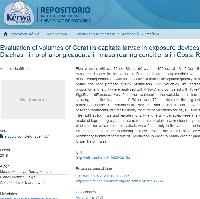Resumen
- Five volumes (60 cc, 70 cc, 80 cc, 90 cc and 100 cc) of L3 of Ceratitis capitata in exposure devices to the parasitoid Diachasmimorpha longicaudata were evaluated in mass rearing conditions with the objective of finding the optimal quantity of host larvae to obtain the best parasite quality parameters. The variables like parasitism, sexual proportion and fertility were analyzed with ANOVA and compared with Tukey’s range test. Significant differences were found for treatment in the variable parasitism (ρ = 0.0244), showing that the treatments of 60 cc and 70 cc obtained the highest number of parasitized larvae. The variables like sex ratio and fertility did not show any difference between treatments, but for fecundity there were variations for days 5 and 3 (ρ<0.0001). The flight ability, male and female mortality and fertility variables were analyzed with the model of logistic regression analysis with autocorrelation correction (response variable is binomial), for which treatment effects were found only in the variable mortality of males for the treatment 70 cc. According to these results, the volume of 70 cc would be the promissory treatment for industrial production in order to obtain greater parasitism and a longer life of males
